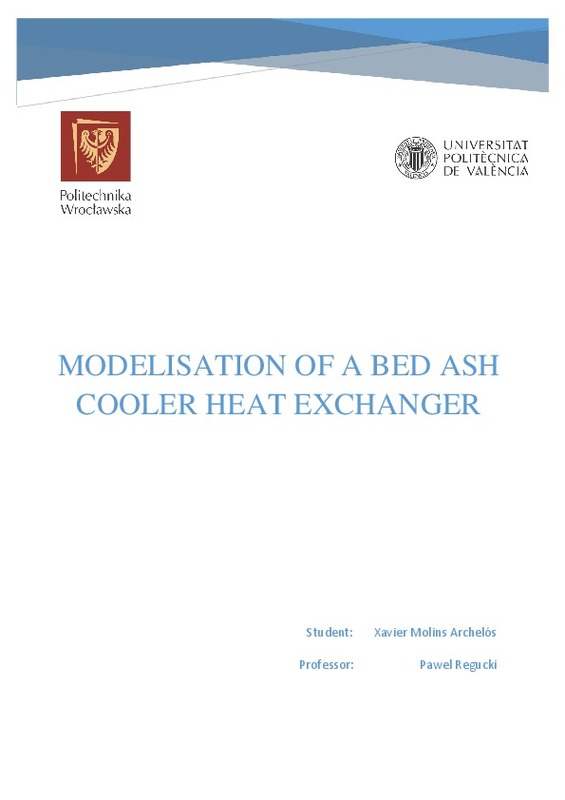JavaScript is disabled for your browser. Some features of this site may not work without it.
Buscar en RiuNet
Listar
Mi cuenta
Estadísticas
Ayuda RiuNet
Admin. UPV
ESTUDIO DE LOS PROCESOS DE FLUJO TÉRMICO EN UN ENFRIADOR DE TORNILLO DE CENIZAS QUE COOPERA CON LA CALDERA CFB
Mostrar el registro sencillo del ítem
Ficheros en el ítem
| dc.contributor.advisor | Payá Herrero, Jorge
|
es_ES |
| dc.contributor.author | Molins Archelós, Xavier
|
es_ES |
| dc.date.accessioned | 2020-06-08T18:40:02Z | |
| dc.date.available | 2020-06-08T18:40:02Z | |
| dc.date.created | 2019-09-30 | |
| dc.date.issued | 2020-06-08 | es_ES |
| dc.identifier.uri | http://hdl.handle.net/10251/145711 | |
| dc.description.abstract | [EN] Nowadays thanks to the industrial development, the increase of standard of living, each country is trying to achieve new goals in terms of renewable sources. In case of Poland, is one of the best countries regarding to biomass. Inside this topic there is some industries working in fluidized bed boilers with the aim to refresh the ashes obtained after the combustion of biomass and coal. At the same time, they are trying to achieve two goals, not only the refresh, even though reobtain the thermal energy from the ashes. This thermal energy can be converted into electrical and be used to cover the energy employed during the process such as, the gas injection, removal ashes, transport the coal and go on. In several factories after obtained the ashes they have to wait some days until the ash’s temperature is reduced, as its temperature around 800-900ºC is hard to work and it is necessary achieve an available temperature for being moved to a secure place. The aim is reducing the time of this process. On the other hand, from international governments have being passed some laws to reduce the quantity of emissions emitted to the atmosphere so, the study of fluidized bed boilers is interesting due to the among of chemical elements which are contained inside and finally, it could cause a reduction of them. Here the most important contaminant elements are NOx and SO2, of course there are more but firstly these two must be eliminated and after there will be included the CO2 and CFC. In fluidized bed boilers, combustion occurs in a controlled manner throughout the home and recirculation system so that the residence time of the ignited particles is much higher than that of conventional boilers, these temperatures are usually lower than 850ºC. As ash softening and melting temperatures are not reached, no slag formation phenomena occur in the boiler. In addition, the combustion temperature is below that of formation of nitrogen oxides of thermal origin, which limits the production of this pollutant. In the combustion process, the sulfur present in the fuel is oxidized to produce SO2, which in conventional boilers escapes with fumes, unlike here it is combined in the boiler itself and thus the installation of a desulfurization process is avoided of gases. | es_ES |
| dc.description.abstract | [ES] Actualmente, en todo el mundo se esta mejorando la eficiencia de las unidades de energía. En Polonia también se están realizando investigaciones para reducir las pérdidas de calor en las centrales eléctricas y en las centrales térmicas y eléctricas. El tópica de este proyecto es el importante estudio de la posibilidad de usar calor residual proveniente de calderas de lechos fluidizados y aprovecharlo con refrigeradores en forma de caracol. La base del proyecto esta basado en las mediciones de flujo térmico en los refrigeradores y el análisis de los parámetros que controlan el rendimiento de estos refrigeradores y como mejorarlos con el aprovechamiento del calor residual de cenizas utilizadas en lechos fluidizados. El objetivo del trabajo es desarrollar un modelo matemático que permita el control de un solo enfriador para maximizar su uso y aumentar al mismo tiempo la eficiencia en la unidad de potencia. El modelo se basa en las ecuaciones de Fourier, por lo que se determinan los coeficientes de transferencia de calor para enfriar agua, escoria y acero. También serán analizados los comportamientos de las temperaturas, paredes y cenizas. | es_ES |
| dc.language | Inglés | es_ES |
| dc.publisher | Universitat Politècnica de València | es_ES |
| dc.rights | Reserva de todos los derechos | es_ES |
| dc.subject | Refrigerador | es_ES |
| dc.subject | Cenizas | es_ES |
| dc.subject | Eficiencia | es_ES |
| dc.subject | Ash cooler | es_ES |
| dc.subject | Efficiency | es_ES |
| dc.subject.classification | MAQUINAS Y MOTORES TERMICOS | es_ES |
| dc.subject.other | Máster Universitario en Ingeniería Industrial-Màster Universitari en Enginyeria Industrial | es_ES |
| dc.title | ESTUDIO DE LOS PROCESOS DE FLUJO TÉRMICO EN UN ENFRIADOR DE TORNILLO DE CENIZAS QUE COOPERA CON LA CALDERA CFB | es_ES |
| dc.type | Tesis de máster | es_ES |
| dc.rights.accessRights | Abierto | es_ES |
| dc.contributor.affiliation | Universitat Politècnica de València. Departamento de Termodinámica Aplicada - Departament de Termodinàmica Aplicada | es_ES |
| dc.contributor.affiliation | Universitat Politècnica de València. Escuela Técnica Superior de Ingenieros Industriales - Escola Tècnica Superior d'Enginyers Industrials | es_ES |
| dc.description.bibliographicCitation | Molins Archelós, X. (2019). ESTUDIO DE LOS PROCESOS DE FLUJO TÉRMICO EN UN ENFRIADOR DE TORNILLO DE CENIZAS QUE COOPERA CON LA CALDERA CFB. http://hdl.handle.net/10251/145711 | es_ES |
| dc.description.accrualMethod | TFGM | es_ES |
| dc.relation.pasarela | TFGM\113434 | es_ES |
Este ítem aparece en la(s) siguiente(s) colección(ones)
-
ETSII - Trabajos académicos [10404]
Escuela Técnica Superior de Ingenieros Industriales






